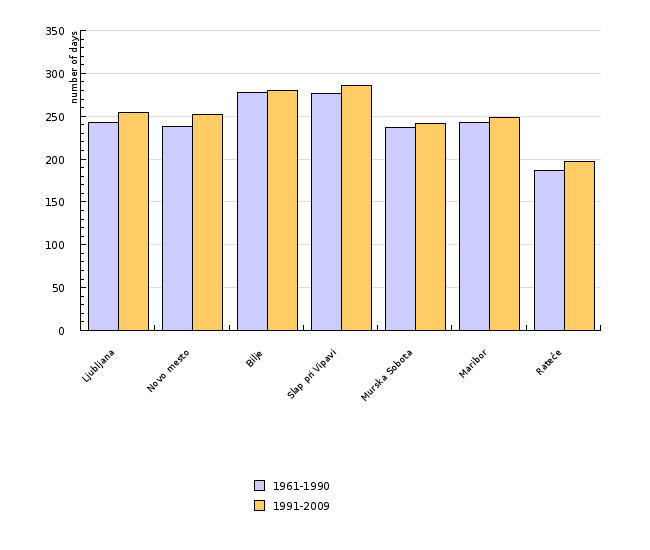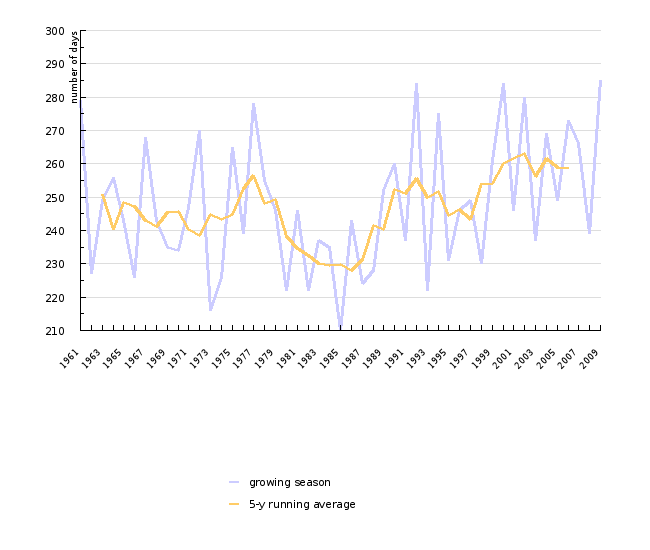[PP06] Annual growing season length

Key message

Climate changes affect the length of the annual growing season. The annual growing season, which is limited by spring and autumn temperature thresholds of 5 degrees C, varies considerably from year to year, but has been getting slightly longer in the past twenty years.
Definition
The length of the annual growing season is the period between the day when the average daily air temperature in spring exceeds the temperature threshold of 5°C and the day when it drops below this value in autumn.
The air temperature of 5°C is generally recognised as the lowest temperature threshold for plant vegetation. The length of annual growing season is defined by the temperature threshold of 5°C and the temperature threshold so determined is used as one of the conditions for the classification of agro-ecological zones.
Charts
Archive of Meteorological Data, Environmental Agency of the Republic of Slovenia, 2010
| Ljubljana | Novo mesto | Bilje | Slap pri Vipavi | Murska Sobota | Maribor | Rateče | ||
|---|---|---|---|---|---|---|---|---|
| 1961-1990 | number of days | 243 | 238 | 278 | 276 | 237 | 243 | 187 |
| 1991-2009 | number of days | 254 | 252 | 280 | 286 | 241 | 248 | 197 |
Archive of Meteorological Data, Environmental Agency of the Republic of Slovenia, 2010
| 1961 | 1962 | 1963 | 1964 | 1965 | 1966 | 1967 | 1968 | 1969 | 1970 | ||
|---|---|---|---|---|---|---|---|---|---|---|---|
| growing season | number of days | 279 | 227 | 249 | 256 | 243 | 226 | 268 | 243 | 235 | 234 |
| 1971 | 1972 | 1973 | 1974 | 1975 | 1976 | 1977 | 1978 | 1979 | 1980 | ||
| growing season | number of days | 247 | 270 | 216 | 226 | 265 | 239 | 278 | 255 | 246 | 222 |
| 1981 | 1982 | 1983 | 1984 | 1985 | 1986 | 1987 | 1988 | 1989 | 1990 | ||
| growing season | number of days | 246 | 222 | 237 | 235 | 210 | 243 | 224 | 228 | 252 | 260 |
| 1991 | 1992 | 1993 | 1994 | 1995 | 1996 | 1997 | 1998 | 1999 | 2000 | ||
| growing season | number of days | 237 | 284 | 222 | 275 | 231 | 246 | 249 | 230 | 261 | 284 |
| 2001 | 2002 | 2003 | 2004 | 2005 | 2006 | 2007 | 2008 | 2009 | |||
| growing season | number of days | 246 | 280 | 237 | 269 | 249 | 273 | 266 | 239 | 285 |
Goals
- To estimate the effect of climate changes on plant development.
- Preparation of adjustment procedures for the newly arising climatic conditions and mitigation of possible adverse effects.
Comment
The rise in average air temperatures and the increased frequency of days with temperatures exceeding the vegetation threshold influence the prolongation of the length of the annual cycle of vegetation. The latter has a non-homogeneous character, with appreciable deviations within the period in question (i.e. 1961-2009). The 5-year running average indicates a slight cyclical oscillation. The last cycle of 5-year running average values indicates the prolongation of the length of the annual cycle of vegetation since the 1990’s, which is also made strikingly evident by the comparison of average values for the periods of 1961-1990 and 1991-2009.
The adjustments to the changed length of the cycle of vegetation are expressed as gradual changes in agricultural technology, which, owing to the nature of agricultural production, is a lengthy process. In introducing new technologies into agricultural practice, special account is to be taken of environmental factors, the laws of environmental protection and supporting information systems (agro-meteorological data). In accordance with the National Environmental Action Programme, reduction of the burden caused by the changing length of the cycle of vegetation (introduction of new varieties) will require upgrading of existing legal and economic instruments for environmental protection (biodiversity, sustainable development), acting in line with the adopted international conventions (Framework Convention of the United Nations on Climate Change, United Nations Convention to Combat Desertification, Convention on Biological Diversity), strengthening supervision over sources of environmental hazards, heightening environmental awareness, enhancing knowledge on environmental issues, and encouraging sustainable forms of agricultural production.
Methodology
Data for Slovenia
Objectives summarized by: Action plan for the Strategy on the Adaptation of Slovenian Agriculture and Forestry to Climate Change (2008) and the Fourth Assessment Report of the Intergovernmental Panel on Climate Change (IPCC) and Synthesis Report (2007).
Source database or source: Archive of Meteorological Data, Environmental Agency of the Republic of Slovenia
Data administrator: Meteorological Office of the Environmental Agency of the Republic of Slovenia.
Data acquisition date for this indicator: 15 September 2010
Methodology and frequency of data collection for the indicator: For the illustration of the length of annual growing season in Slovenia, an analysis was made of daily air temperatures at 7 meteorological stations for the period of 1961-2009 (meteorological stations: Rateče, Bilje, Slap pri Vipavi, Ljubljana, Novo mesto, Maribor, Murska Sobota).
Data processing methodology: Criteria for the calculation of the length of annual growing season is taken from the CCL/CLIVAR/JCOMM (Expert Team on Climate Change Detection and Indices, European Climate Assesment & Datasets) methodology, (www.eca.knmi.nl/indicesextremes), which defines the length of annual growing season as a number of days between spring and autumn temperature thresholds. The temperature threshold is exceeded when average daily temperatures in spring are higher and in autumn lower than 5°C for at least six consecutive days. In relation to the climate situation in Slovenia, the spring condition has been changed in such a way that the spring temperature threshold occurs after the last series of six or more consecutive spring days with a temperature above 5°C, thereby excluding at least six-day long early winter warming.
Information concerning data quality:
Advantages and disadvantages of the indicator: Advantages: Basic data for the indicator have been collected in accordance with the standards for carrying out meteorological measurements and observations. The data has been verified and is comparable in time and space.
Disadvantages: The data has been collected at a selected point (meteorological station); the indicator is not distributed over space.
- Relevance, accuracy, robustness, uncertainty: The accuracy of measurements and data quality comply with the standards for performing meteorological measurements and observations in the Republic of Slovenia and the recommendations of the World Meteorological Organisation.
Reliability of the indicator (archival data): The data for the indicator is publicly available in a unified and verified meteorological database in the Republic of Slovenia.
Uncertainty of the indicator (scenarios/projections): No scenarios/projections available.
- Overall assessment (1 = no major comments, 3 = data to be considered with reservation):
Relevance: 1
Accuracy: 1
Completeness over time:1
Completeness over space: 1










